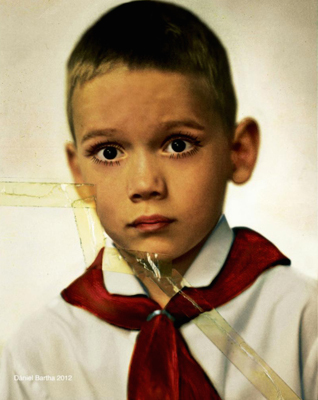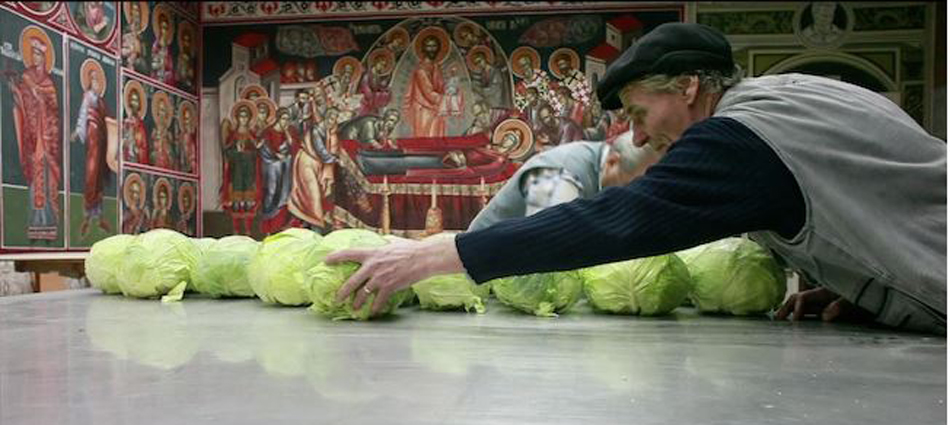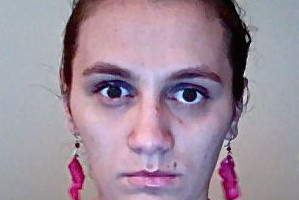The exhibition “Few were happy with their condition” at Kunsthalle Winterthur reunites twelve Romanian artists with their recent works. In a curatorial aim to exhibit and understand Romanian art today, Olga Ștefan assembles the Romanian artistic production and discovers that Romanians have a hard time finding happiness while crossing an endless period of transition, from communism to western democracy, for more than 25 years now. Therefore, few were happy!
The art show focuses on two mediums for their immediate quality: photography and video. More specifically, video has the inherent capacity to serve as a supreme and privileged symptomatic indicator for the Zeitgeist. It can represent the cultural dominant for a new economic and social situation. Video is the most significant allegoric and hermeneutic vessel for describing a renewed system.
What stands out in this art show is the fact that almost all artists seem to be fully aware of the special place they occupy in time and, more specifically, they offer a special take on history, on the Romanian past.
Once the artists reunited by Olga Ștefan (Ciprian Mureșan, Dan Acostioaei, Jozsef Bartha, Alexandra Croitoru, Cristina David, Monotremu, Claudiu Cobilanschi, Vlad Nancă, Bogdan Gîrbovan, Ștefan Sava, Alex Mirutziu, Ștefan Constantinescu, Cristi Pogăcean and Dan Perjovschi) owned up to the idea of history, it offered the chance for a certain engagement, a savior-like apparition of remembrance, a simple illustration or the unfolding of a parable, a source of inspiration for contumacy.
“Few Were Happy with their Condition” is the title of the exhibition. What condition might this be? The title is from Cristina David’s song The Voice (2013). In this video, the artist helps the dead communicate with the living, via a train station info board. This was a pertinent choice because the show covers the overall theme of men and women in the past and present, and the links between them. The dead, in their invisible state, seem to share the state of the living, which are also unseen in the video, as well as the artist’s state, because she also belongs to this invisibility. One of the major themes of the exhibition is to talk about the artist’s condition and his stance in society. At the end, it draws the line and makes a disheartening recap of the situation; sometimes the periods overlap and the past and the present slide into one another.
The biopic told through the self-portrait is the essence of Alex Mirutziu’s artistic method. In Self portrait at 32 (2014), two fixed frame videos play on a loop. The ensemble of the work is walking the fine line between photography and video and it shows the image of a shrub growing on abandoned buildings. Using a melancholic poem, the artist makes a metaphor for the state of homosexuality and declares his work a tribute to the outcastes. Living is suffering, it is loneliness. The body? A “non-body”. But in the spleen of its position in the Romanian society, the shrub grows its branches towards the sky. This might remind us of another self-portrait called Ideal situation: land-artist-sky (1969) by Gina Pane, in which the artist takes us head on, on a rocky terrain, as still as a tree.
The immobility from Alex Mirutziu’s work finds a double in Alexandra Croitoru’s. The Cabbage Process (2012) follows an old administrator at The University of Fine Art in Bucharest, as he goes through the process of preserving cabbages. This traditional household gesture that has crossed over two eras, communist and post-communist, is the witness for the permanency of things. To pickle cabbage takes time, thus becoming an analogy for the time needed to transform a country.
This is a trend to behold! After 1989, right after the Iron Curtain had fallen, many international artists owned up to history and incorporated the past in their artistic production. This is one of the fundamental components of post-modern art. At this point, a question must be asked: is there legitimacy to exposing artists based on their nationality in the global context in which we live? Let’s keep in mind the educational and professional route of the artists and the curator that took place beyond Romanian borders for most, with some of the artists having lived/still living abroad. Another question comes to mind: where are the Romanian artists that produce “non-Romanian” art works? Is there a certain “exotic” feel for a certain kind of Romanian artist? Is there a type of art that would reinforce our image of Romania? To what extent does Mircea Cantor’s Western success is due to the “folkorisation” of his work? Do we really have to keep on doing things the Romanian way, talk about our unhappiness due to living in Romania, about the lack of money for production, the difficult condition of the artist and his never-ending battle to convince the world, and especially himself, that he has earned his place within society?! Is the pessimism of this art show a dominant for the creation of contemporary Romanian art?
It appears that the exhibition wants to present and interpret the works from the victim’s point of view, as well as a generally sad perspective. Luckily, humor comes in to save the day (us). This perspective is one of the realities of producing Romanian art in the present, but things would be just as interesting if people would look towards art that is uplifting, more future oriented. To be permanently part of social realism, isn’t that what’s blocking our way out of this pessimistic state?
The Romanian new wave seems to maintain a ratio between the aesthetics and the idea behind the art show, if we were to exclude the specific form and language of the cinema. Born in the early 2000s, this type of cinema is interested in Romania’s past, the historic state which its nation has endured for half a century. Looking into the specific social reality, filmmakers have extended their artistic curiosity towards contemplating the state of man. The Romanian new wave is characterized by social realism and a clear closeness to the communist past and to the neoliberal future as well. For more than ten years, this way of making movies is ever more successful on the international cinema scene. Nothing seems to evolve. Could it be that this type of art show is a vector for the general stagnation within this post-communist Romanian condition? Are we trying to remain pessimistic because this is the dominant and therefore high-selling image?
Few Were Happy with their Condition
February 22 – April 6 2015
Kunsthalle Winthertur
Artists: Ciprian Mureșan, Dan Acostioaei, Jozsef Bartha, Alexandra Croitoru, Cristina David, Monotremu, Claudiu Cobilanschi, Vlad Nancă, Bogdan Gîrbovan, Ștefan Sava, Alex Mirutziu, Ștefan Constantinescu, Cristi Pogăcean, Dan Perjovschi
Curator: Olga Ștefan
POSTED BY
Roxana Sima
Roxana Sima, born 1980 in Romania. She graduated from HEAD in Geneva, Switzerland, and is currently pursuing her MA at the same institution. She utilizes the instruments of contemporary art and more r...





Comments are closed here.